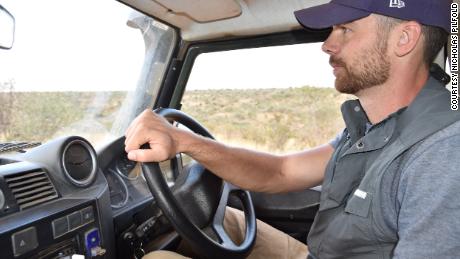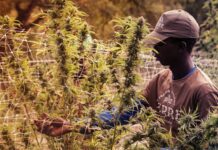Biologists photographed rare footage of the sleek big cat walking majestically in Kenya — the first time the animal has been photographed in Africa since 1909.
Nick Pilfold, a San Diego Zoo global scientist, said they captured the footage after months of watching and waiting. His team of biologists had placed remote wildlife cameras to track the leopard population near Loisaba Conservancy in Laikipia County last year when they heard unconfirmed reports of a possible black leopard sighting.
“We intensified our camera placement in the area the reports were being made,” he said Tuesday night. “Within a few months, we were rewarded with multiple observations on our cameras.”
The female leopard’s coat color is pitch black as a result of melanism, a gene mutation that results in an over-production of pigment, Pilfold said. It’s the opposite of albinism — and although the leopard’s coat appears black during the day, its rosette patterns are visible in nighttime infrared imagery.
While there have been reports of sightings of black leopards — also known as black panthers — the last confirmed observation was in Ethiopia more than a century ago, he said.
“Melanism occurs in about 11% of leopards globally, but most of these leopards live in South East Asia,” Pilfold said. “Black leopards in Africa are extremely rare, and prior to the observations in our published paper, the last confirmed observation was 1909 in Ethiopia.”
Black leopards may have been living in Kenya all along, but there’s been no footage to confirm the observations until now, Pilfold said.
The black leopard’s sighting was published in the African Journal of Ecology.
Leopards are described as critically endangered on the International Union for Conservation of Nature’s Red List of Threatened Species.
The total extent of the animal’s population decline is still unknown, San Diego Zoo said in a statement. But several factors have sharply reduced their numbers, including hunting, habitat loss, competition for prey, and conflict with livestock and farmers.
Pilfold is part of a team from the San Diego Zoo working with local partners, including the Kenya Wildlife Service, to monitor leopard populations in the area and help preserve the species.
He marveled at the coincidence of the location of an animal that’s also called the black panther — the title of one of last year’s biggest movies.
“Coincidentally, our observations are very close to where the fantasy Marvel comic country of Wakanda is suggested to be located,” he said.
Views: 248

















